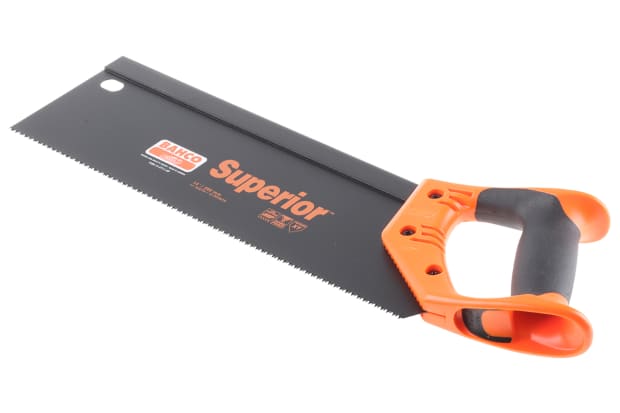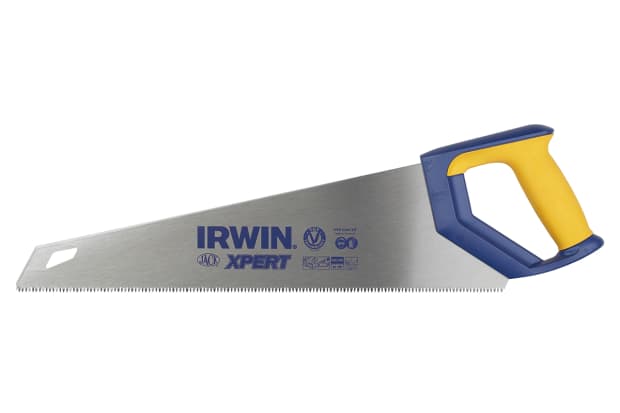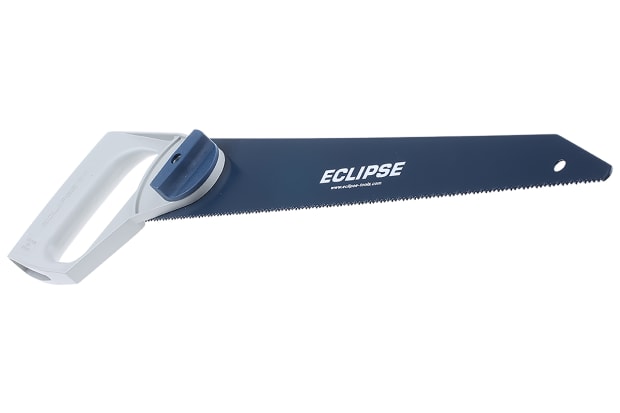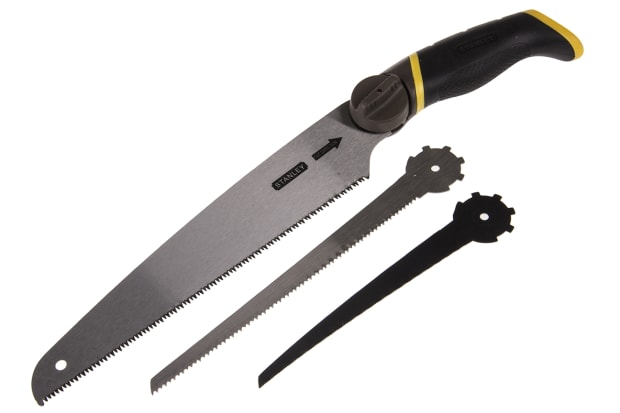- Published 8 Oct 2024
- Last Modified 8 Oct 2024
- 19 min
A Complete Guide to Understanding Hand Saws

In this detailed guide, we explore the various types of hand saws available on the market today, highlighting their various types and applications. Our goal is to provide you with the knowledge needed to choose the right hand saw for your specific tasks, whether you're cutting wood, plasterboard, or other materials.
We will discuss popular varieties such as tenon saws and pruning saws, while also offering essential tips on effective usage techniques. By understanding the key differences between these tools, you can make informed choices that improve your efficiency and results in any project.
What are Hand Saws?
Hand saws, sometimes referred to as handsaws, are fundamental tools that every well-equipped toolbox should include. They rank alongside essential tools like hammers, chisels, and wrenches in their importance for a variety of home improvement and maintenance tasks.
While modern power tools provide speed and convenience for many cutting applications, they are not always the best choice. In certain situations, factors such as accessibility, safety, weight, and the need for precision make hand saws a superior option compared to their powered counterparts.
There are numerous types of hand saws available, each designed for specific tasks. Understanding which type of hand saw to use for a given job is crucial for achieving optimal results.
Types of Hand Saws
Hand saws are versatile tools that come in many varieties, each designed for specific cutting tasks. While some hand saws are intended for general use, others are precision-engineered for specialised applications. Understanding these differences is essential for selecting the right tool for your project.
It's important to note that the terminology used for hand saws can vary among suppliers, manufacturers, and users, leading to potential confusion. For instance, you might encounter various names for similar saw types when shopping for a timber saw, including:
- Ripping Saw: Designed for cutting wood along the grain. Typically, 24 to 26 inches long with 4 to 7 TPI (teeth per inch), it cuts aggressively but leaves a rough edge.
- Crosscut Saw: Used for cutting across the grain of wood. Usually measuring 24 to 26 inches long with 8 to 11 TPI, it produces smoother cuts compared to ripping saws.
- Panel Saw (Shortcut or Box Saw): Shorter than standard crosscut saws, panel saws are portable and ideal for making crosscuts in larger sheets of wood, such as plywood or MDF.
- Short Cut Saw: A compact version of a panel saw designed for quick cuts in various materials.
- Wood Saw: A general term that can refer to any hand saw used primarily for cutting wood.
- Tenon Saw: This type of back saw is used for making precise cuts in wood joints and typically features a high TPI for clean edges.
- Back Saw: Known for its rigid back that prevents kinking, this saw is perfect for making precise cuts in molding and trim work.
- Dovetail Saw: Similar to a back saw but smaller with finer teeth; it is ideal for making intricate cuts necessary for dovetail joints.
- Pruning Saw: Designed specifically for cutting branches and shrubs in gardening tasks; it often features curved blades for better manoeuvrability.
- Plasterboard Saw: Also known as a drywall saw, this tool is designed to cut through wallboard and gypsum quickly and efficiently.
- Coping Saw: Featuring a thin blade held in a deep frame, the coping saw is perfect for intricate cuts such as coping joints in moldings. It can also cut through plastic and light metals.
- Fine Finish Saw: This type of saw is designed for achieving smooth finishes on wood surfaces.
- Fretsaw: Similar to the coping saw but with a finer blade, it is used for detailed work and intricate designs.
- Hacksaw: Primarily used for cutting metal, hacksaws feature fine teeth held under tension in a steel frame. They are versatile enough to cut through various materials, including plastic.
- Frame Saw: A traditional hand saw with a frame that allows the use of different blades depending on the task at hand.
- Bow Saw: Designed primarily for outdoor use, bow saws excel at cutting tree branches and logs quickly.
- Hardpoint Saw: These basic saws feature induction-hardened teeth and plastic moulded handles. They are ideal for general-purpose cutting but cannot be resharpened once dull.
- Keyhole Saw: A thin blade designed specifically for cutting small circles and curves in wood or drywall.
- Punch Saw: Used mainly in woodworking to create holes or cut curves in various materials.
- Compass Saw: Longer than a keyhole saw; it is used for heavier tasks like cutting holes in subflooring or creating larger curves.
- Pull Saw: Cuts on the pull stroke, providing greater control and reducing the chance of kinking during use. This design is particularly useful in fine woodworking applications.
- Dozuki Saw: A Japanese-style pull saw that features a fine blade ideal for precise cuts in woodwork.
- Ryoba Saw: Another Japanese hand saw with two different tooth patterns on each side of the blade, one side is designed for ripping while the other is meant for crosscutting.
- Kataba Saw: A single-edged Japanese saw that excels at making clean cuts across the grain of wood.
- Pole Saw: Designed with an extended reach, pole saws are used primarily for pruning high branches without needing a ladder.
- Veneer Saw: A specialised tool used to cut thin sheets of veneer without tearing or damaging the material.
The overlap in terminology often results in several names being used interchangeably, even when referring to what appears to be the same basic type of hand saw. In many cases, the distinctions between these subtypes can be subtle. For example, wood saws designed for straightforward timber cutting may be labeled as rip saws, panel saws, or crosscut saws depending on their intended use.
Similarly, tenon saws might be categorised as back saws or dovetail saws by different suppliers. Various hand saws designed for making holes or curves, such as punch saws, keyhole saws, compass saws, and fretsaws, may also serve similar purposes despite their unique designs.
To simplify understanding, this guide will focus on four major categories of hand saws based on their primary material uses: wood saws, metal saws, plasterboard saws, and pruning saws.
Hand Saw TPI Guide
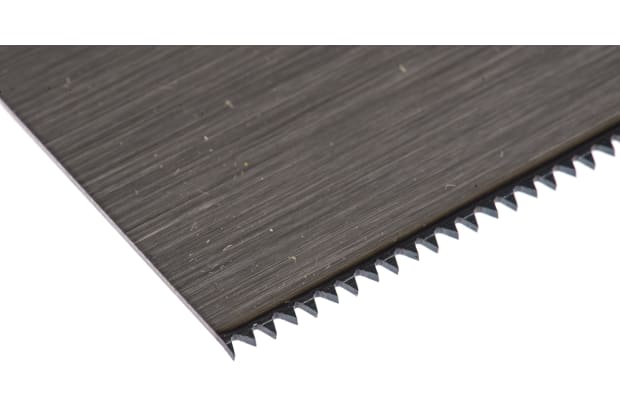
Understanding hand saw TPI, or teeth per inch, is crucial when selecting the right manual cutting tool for a specific job or material. TPI is often one of the most significant factors that differentiate the various types of hand saws available on the market.
In simple terms, the general rule of thumb is that the higher the TPI of a saw blade, the finer and smoother the cut will be. This means that tools designed for detailed or precision work—such as fretsaws and coping saws—typically feature higher TPI counts. High TPI blades are also preferred when cutting thinner woods and metals, as they provide cleaner edges.
Conversely, hand saws intended for less precise tasks, such as pruning branches or cutting larger planks and sheet materials, usually have lower TPI ratings. Lower TPI counts are better suited for thicker, green, or treated woods. Hacksaws, which are primarily used for cutting metal and plastic, often have relatively high TPI blades due to the physical demands of those materials; however, they are not typically used for detailed work.
When exploring hand saw options, you will generally find products categorized by their TPI as follows:
- Coarse-toothed saws: Blades with fewer than 7 TPI are classified as coarse-toothed saws. These are ideal for quick cuts in thick materials.
- Medium-toothed saws: Blades with 7 to 11 TPI fall into this category and are versatile enough for a variety of general cutting tasks.
- Fine-toothed saws: Blades with 12 or more TPI are typically labeled as fine-toothed saws. These are best suited for precision cuts and detailed work.
Selecting the appropriate TPI for your hand saw depends largely on the material you are working with and the type of cut you need to achieve. For example:
- For Rough Cuts: If you need to make quick cuts through softwood or larger timber pieces, a saw with a lower TPI (around 7-10) will allow you to work faster without concern for finish quality.
- For Fine Cuts: When working on projects that require a clean edge—such as furniture making or trim work—a higher TPI (11-15) is preferable. This will ensure a smoother finish with less splintering.
- For Metal Cutting: Hacksaws designed for metal typically have a higher TPI ranging from 18 to 32, allowing them to make clean cuts through tougher materials.
In the following sections, we will explore different types of hand saws tailored for various materials and applications, helping you make informed decisions for your woodworking projects.
Hand Saws for Cutting Wood
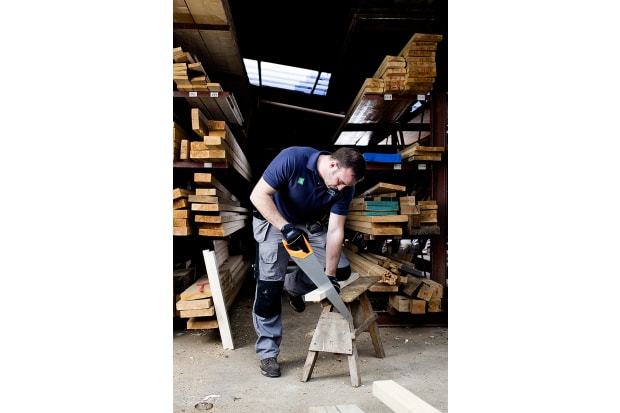
Selecting the best hand saw for cutting wood can be challenging due to the wide range of tasks encompassed by the term "cutting wood." For instance, sawing through a log or tree branch is vastly different from making precise cuts in a furniture panel. Similarly, creating smooth curves on handcrafted woodwork requires a different approach altogether.
Each of these scenarios demands varying speeds and forces to ensure the job is executed correctly. Consequently, the ideal hand saw for each situation will differ. A useful guideline to follow is the TPI (teeth per inch) rule:
- Fine-toothed saws are best suited for jobs requiring slower speeds and higher precision. A higher TPI typically indicates a finer blade, resulting in smoother cuts, although progress through thicker or harder woods may be slower.
- Coarse-toothed saws excel at quickly cutting through thicker or tougher materials. The wider gaps between teeth allow them to remove more wood with each stroke, but the finish may not be as neat.
Hardpoint saws are an economical and convenient option for various simple woodcutting tasks. These basic saws feature plastic-molded handles and sharp, induction-hardened teeth. While general-purpose hardpoint saws can handle most types of wood, it's important to note that their treated blades cannot be sharpened. Once the teeth dull, the entire tool must be replaced, making them more suitable for occasional users rather than those who frequently work with hand saws.
Hand Saws for Cutting Metal
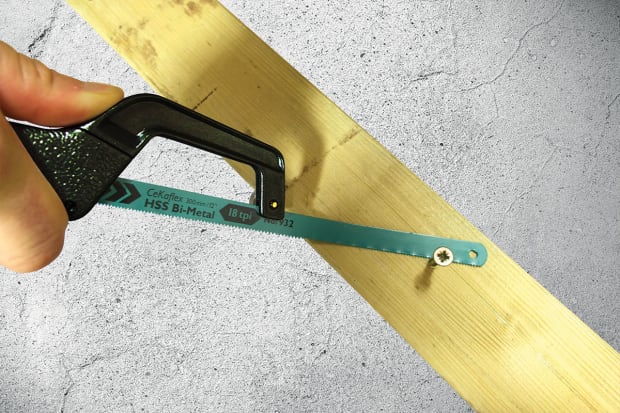
When it comes to cutting metal, many people turn to the traditional hacksaw. This tool consists of a narrow and flexible blade tensioned between two ends of a rigid C-shaped frame. It is widely recognised as a reliable choice for cutting thin metal sheets by hand.
However, selecting the right hand saw configuration for cutting metal involves considering several factors:
- The specific properties of the metal you will be cutting
- The size and thickness of the sheet
- The shape of cut required
- The desired finish quality
Even if you've decided on using a hacksaw, paying attention to variables such as TPI count and blade material can significantly impact your results. Much like with wood saws, matching TPI count and material properties is key:
- Lower TPI blades are better suited for tougher or thicker metals like iron and steel but will produce rougher cuts.
- Higher TPI blades yield finer cuts and are generally preferred for thinner or softer metals such as aluminium and copper.
An Illustrated Guide to Hand Saws
As previously discussed, there is a wide variety of hand saws available, each designed for specific tasks. When exploring the main types of hand saws, you may encounter slight variations in terminology used by different manufacturers and suppliers, which can lead to confusion.
To help clarify this, here’s an overview of some common hand saw types:
General-purpose Hand Saw
Similar Names: Panel Saw, Rip Saw, Wood Saw
General-purpose hand saws are versatile tools suitable for a range of cutting tasks, primarily in wood.
Hardpoint Saw
Similar Names: Hand Saw, Pull Saw, Toolbox Saw
Hardpoint saws feature induction-hardened teeth that maintain sharpness longer but cannot be resharpened once dull.
Plasterboard Saw
Similar Names: Drywall Saw, Jab Saw
Designed specifically for cutting drywall and plasterboard, these saws have coarse teeth for quick cuts.
Fine Finish Saw
Similar Names: Coping Saw, Fretsaw
These saws excel at intricate cuts and detailed work, making them perfect for shaping wood and creating joints.
Pruning Saw
Similar Names: Garden Saw, Log Saw, Branch Cutter
Pruning saws are designed for trimming branches and shrubs in gardening tasks; they often have curved blades for better manoeuvrability.
The Anatomy of a Hand Saw
Understanding the anatomy of a hand saw is essential for effectively using and maintaining this versatile tool. Each component plays a critical role in the saw’s performance, and knowing the correct terminology can enhance your woodworking skills. Below, we break down the main parts of a hand saw and their functions.
Key Components of a Hand Saw
- Handle: The handle is the part of the saw that you grip while cutting. It is designed for comfort and control, allowing you to maneuver the saw effectively. Handles can be made from various materials, including wood, plastic, or composite materials, and should provide a secure grip to prevent slipping during use.
- Back: The back is the top edge of the saw blade, which provides stability and prevents kinking during cutting. In backsaws, this edge is often reinforced with metal to enhance rigidity and precision in cuts.
- Saw Blade: The blade is the primary cutting component of the saw, typically made from high-carbon steel or stainless steel. Its length, thickness, and flexibility determine how efficiently it cuts through different materials. A longer blade is ideal for larger pieces of wood, while a shorter blade allows for more precise cuts in tight spaces.
- Heel: The heel refers to the end of the blade closest to the handle. This part is crucial for starting cuts and provides leverage when pushing through tougher materials.
- Teeth: The teeth are the sharp points along the edge of the blade that do the actual cutting. The configuration, shape, and number of teeth per inch (TPI) significantly influence how well the saw performs. Higher TPI results in smoother cuts but slower cutting speeds, while lower TPI allows for faster cuts but rougher finishes.
- Toe: The toe is the opposite end of the blade from the heel. It often features a pointed design that helps initiate cuts in materials.

What are Tenon Saws?
A tenon saw is a specialised type of back saw, specifically designed for making precise cuts in wood. While any saw with a reinforced spine can be classified as a back saw, tenon saws have unique characteristics and applications that set them apart, making them ideal for controlled and accurate woodworking tasks.
Tenon saws are easily identifiable due to their distinct features:
- Rigid Spine: A tenon saw typically has a reinforced spine along the top (non-cutting) side of the blade, which is usually made from steel, brass, or occasionally wood. This spine provides stability and prevents the blade from bending during use.
- Short and Sturdy Blade: The blade of a tenon saw is relatively short and robust, often measuring between 250 mm to 300 mm (approximately 10 to 12 inches). It ends in an enclosed pistol grip handle that enhances user safety and control; this handle is generally non-removable.
- Teeth Per Inch (TPI): The most common TPI counts for a tenon saw range from 10 to 14. This configuration allows for slower but more controlled cuts compared to coarser hand saws, making it suitable for detailed work.
- Cutting Stroke: Some tenon saws are designed to cut only on the forward stroke (known as ‘push saws’), although there are exceptions that allow cutting on both strokes.
Tenon saws are primarily used for making short, accurate cuts in precision tasks such as joinery and furniture-making. They get their name from their common application in creating tenons for mortise and tenon joints.
The characteristic spine of the tenon saw helps maintain the blade's rigidity while cutting, ensuring clean and precise cuts. This design also limits the depth of cut, which is essential when crafting mortise and tenon joints. Tenon saws excel at cutting across the wood grain; for cutting along the grain, you would typically use a rip saw or panel saw.
What are Pruning Saws?
As their name suggests, pruning saws are designed for quickly trimming overgrown branches, logs, twigs, and other thick garden foliage. These hand tools typically feature medium-long blades that are often curved and have a relatively low TPI count, which enhances their effectiveness when sawing through green or live wood. Folding pruning saws are also popular for easy storage throughout the year.
Smaller, straight-bladed pruning saws are ideal for cutting thinner branches of young or sap-heavy wood. These models usually feature a slightly higher TPI count, typically around 7-8.
Larger curved-blade pruning saws with wider tooth spacing (5-7 TPI) are better suited for thicker, older branches. Their rugged design allows for quicker removal of bush and tree limbs up to approximately 2.5 inches in diameter. While fewer strokes are required with these saws, the resulting cut may not be as smooth or delicate.
Plasterboard Saws
Plasterboard saws, often referred to as jab saws or drywall saws, are specifically designed for cutting holes and voids in wall or ceiling panels.
These tools are characterised by their medium-length, narrow blades that taper to a sharp point. Plasterboard saws often feature a curved handle at the wider end of the blade. Their overall appearance is similar to that of compass saws; however, plasterboard saw blades are generally shorter.
Plasterboard is typically composed of gypsum plaster sandwiched between sheets of paper or sometimes plywood. Drywall saws excel at making rough cut-outs around electrical sockets and other fittings due to their fine-tipped blades, which make it easier to pierce through the panel to initiate cuts.
These saws are not typically used for precision work since they usually have a lower TPI count, resulting in a rough finish that will often be concealed behind fascia or finishing panels. The flexible blade design facilitates angled or curved cuts. For more precise drywall work, many professionals prefer using safety knives or box cutters.
How to Sharpen a Hand Saw
The question of how to sharpen a hand saw arises frequently among woodworking enthusiasts and DIYers alike. Over time, saws that have been heavily used or improperly stored can become noticeably dull. This dullness often becomes apparent after just a few strokes through the material, making it challenging to achieve clean, precise cuts.
A dull hand saw will struggle to bite into the material at the start of a cut, making it difficult to maintain straight lines or neat edges. Additionally, cutting through thicker materials can become laborious and frustrating. In contrast, a well-maintained hand saw with sharp teeth will glide smoothly through wood, providing clean and accurate results.
Sharpening a hand saw is not overly complicated, but it’s crucial to perform the task correctly and safely. It’s also important to note that not all saws are suitable candidates for sharpening. For instance, hardpoint saws feature teeth that have been treated for durability but are not designed for resharpening. In some cases, especially with cheaper hand saws, it may be more economical to replace the blade or the entire tool rather than invest time in sharpening.
Improper sharpening techniques can be as damaging as neglecting the tool altogether:
- For rip cut saws, if one or two teeth become slightly shorter than the others due to wear or inaccurate sharpening, it may not significantly affect performance.
- Conversely, if one or two teeth are longer than the others, you may experience uncomfortable dragging and uneven cutting during use.
- With crosscut saws, the 'set' of the teeth (the alternating angles of the teeth) may require adjustment over time. If the set is too narrow, the blade may bind during cutting; if too wide, it may feel loose in the kerf and wander off course.
Once you’ve invested in a quality hand saw, you’ll likely want to keep it in your toolkit for years to come. Thus, learning how to sharpen it properly can greatly extend its lifespan and performance.
To sharpen your hand saw effectively, gather the following tools:
- A vice to securely hold the saw blade
- Vice blocks or scrap wood to protect the tool
- A mill file (flat) and a taper saw file (triangular)
Both types of files are commonly included in good file sets. Ensure that any triangular file fits comfortably between the teeth of your saw.
Steps for Sharpening a Hand Saw
- Secure the Blade: First, place the blade as low as possible in the vice while ensuring that the teeth remain exposed. This positioning minimises wobble and flex during filing.
- Leveling with Flat Mill File: Use the flat mill file to level out the tops of the teeth. Hold it level across the tops of the teeth and perpendicular to the blade. Apply light, even pressure in a side-to-side motion along the entire length of the blade. This action will create small flat tops on each tooth that will appear shiny when viewed in light.
- Sharpening with Taper Saw File: Switch to the taper saw file and insert it between two teeth at a slight angle toward the tip of the saw so that it rests against the spine of the tooth being sharpened. Again, hold it level and perpendicular to the blade. Make two to three light sideways passes on each tooth along the full length of the blade while maintaining consistent pressure and stroke count.
- Final Check: Once all teeth have been reduced to a consistent size with shiny points at their tips, your saw has been successfully sharpened. Test your newly sharpened hand saw on a piece of wood; if necessary, make small adjustments until you achieve optimal cutting performance.
Popular Brands
Bahco
Browse the full range of hand saws available from Bahco and shop online today with RS.
Irwin
We stock a wide variety of Irwin hand saws, with products ranging from hardpoint saws to general-purpose hand saws.
Spear & Jackson
Spear & Jackson hand saws are suitable for a wide range of uses and applications. See the full range online today.
Stanley
See our full range of hand saws from leading brand Stanley and discover the product best suited to your specific requirements.
